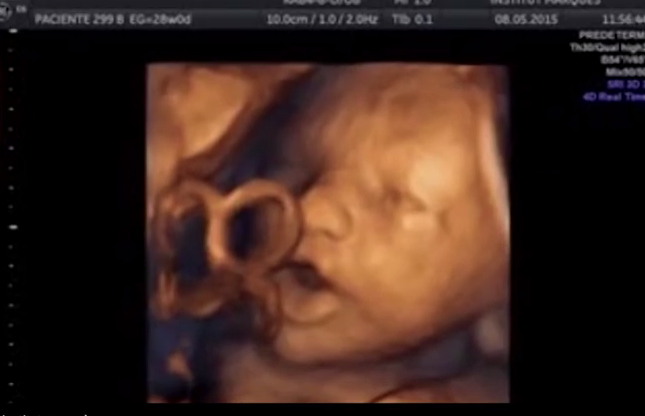4D Ultrasound Scans Reveal Babies Can Sing Along During Moms' Second Trimester

Singing along to our favorite songs may actually be a skill we acquire even before we're born. According to a recent study published in the journal Ultrasound, unborn babies can “sing and dance” in the womb as early as 16 weeks, when exposed to music via an intravaginal device, Babypod.
Medical literature has found the fetus fully develops the inner ear at week 16 of gestation and has a functioning auditory system from week 26. However, for the first time, researchers at the Instituto Marques in Barcelona, Spain, found the fetus begins to hear at week 16 of pregnancy, which they observed is "expressed through specific movements of the mouth and tongue," they said in a press release.
The fetus is able to receive sounds from inside the mother's body, such as her heartbeat, breathing, and intestinal activity. It can also perceive sounds the mother makes, including when she is speaking or walking with high heels, in addition to other external sounds. The majority of sounds are perceived as whispers (around 30 decibels), while the mother's voice during normal conversation (60 decibels) is barely detected (24 decibels).
To explore the behavior of the fetus and its response to stimuli, the researchers recorded facial movements identified on 3D/4D ultrasound in 106 normal pregnancies between 14 and 39 weeks of gestation. The women were submitted to either play music abdominally (against the bump) or intravaginally (Babypod). The fetuses were all played Johann Sebastian Bach's “Partita in A Minor.”
Previous to starting the music, the researchers performed ultrasound scans that showed around 45 percent of fetuses made spontaneous head and limb movements, while 30 percent moved their mouth or tongue, and 10 percent stuck their tongues out. Now, when exposed to sound through the Babypod, 87 percent of fetuses reacted with head and limb movements, along with specific mouth and tongue movements, that stopped when the music stopped. Furthermore, 50 percent of the fetuses reacted with a surprising movement: opening their jaw very wide and sticking their tongue out as far as it would go.
Dr. Marisa Lopez-Teijon, leader of the study and a specialist in assisted reproduction at the Instituto Marques, said the findings show fetuses respond to music intravaginally by moving their mouth and tongue "as if they were trying to speak or sing.”
In comparison, when a set of headphones were placed over a pregnant woman's bump and the music was played through the abdomen, researchers saw no changes in fetal facial expression. They did, however, find “the further on the mother is in the pregnancy, the more striking the facial movements,” became.
So, how does this response occur?
The researchers suggest that music elicits a response that fetuses express as vocalization movements, as it stimulates brain circuits that are responsible for language and communication. Once the inner ear is fully formed, an auditory stimulus with rhythm and melody is activated. A mass of nerves called the inferior colliculus detects sounds and becomes stimulated. It's responsible for mouth and jaw movement and for vocalization.
A 2013 study published in the journal Proceedings of the National Academy of Sciences confirms stimulus for the neurological development of the baby is essential weeks before they are born. Expectant mothers who would coo and chat to their babies while pregnant not only stimulated the fetus, but they also shaped their child’s brain. Babies who listened to a CD with two, four-minute sequences of made-up words like “tatata” or “tatota” — said several different ways with different pitches — from week 29 until birth were able to recognize these made-up words and the pitch changes after birth.
Both studies suggest pregnant mothers play a significant role in their child's neurodevelopment even before they are born. Any type of sensory stimulation is useful, and these studies confirm the sooner, the better. Music is able to stimulate language learning via the primary brain circuits involved in communication.
Another medical implication presented is it can help doctors detect if a baby is deaf or not. Deaf people can hear vibrations, but not music. So, if the fetus does not respond during the ultrasound, this does not mean that the baby cannot hear.
Expectant moms, don't be afraid to “rock on” with your babies in the womb.
Sources: Lopez-Teijon M, Garcia-Faura A, and Prats-Galino A. Fetal facial expression in response to intravaginal music emission. Ultrasound. 2015.
Partanen E, Kujala T, Naaatanen R et al. Learning-induced neural plasticity of speech processing before birth. PNAS. 2013.



























